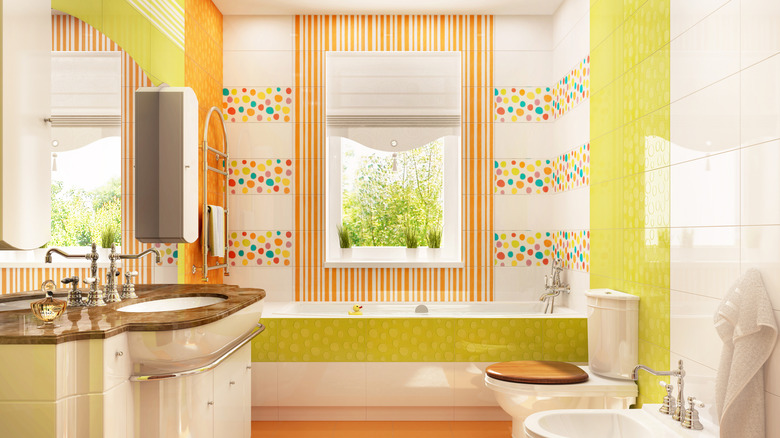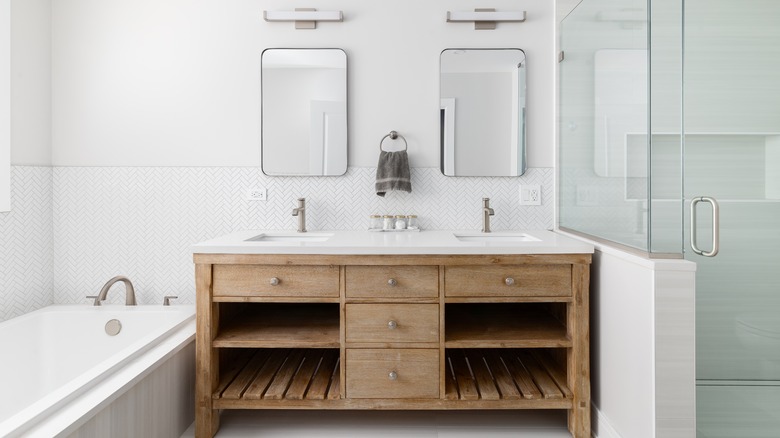The Bathroom Tile Mistake You Need To Stop Making
For many of us, the bathroom is like a sanctuary where we can relax and do our business privately. However, when the tile work inside the bathroom is a dizzying mishmash of textures, colors, and patterns, having a calming retreat is nearly impossible. This is why it's important to keep in mind one major design rule when choosing tile for the shower and bathroom: Stick to just a few tile types per space.
"A good rule of thumb is to use no more than 3 different tiles for bathrooms," Corey Willis, decor coach of Hey There Home, explained. "At the least, you'll have bathroom floor tile, and bathroom shower tiles or bathtub wall tile. Then you might have wall tile, and/or accent tile for your bathroom." While variety can be beautiful, using too many different tiles in one bathroom can be overwhelming, disrupting the tranquil atmosphere most people want in a washroom.
While you might think mixing a bunch of bathroom tiles will create a custom, designer look, it's really a recipe for visual chaos. Limiting the tile to three types offers just enough variety to keep things interesting without making the bathroom feel disjointed and overloaded.
Why too many tiles can ruin your bathroom's look
A bathroom should always feel like a cohesive space. It should be calm, clean, and thoughtfully designed. When designing the bathroom, you should first know that the key to picking the best bathroom tiles comes down to your lighting. You wouldn't want dark tiles in a poorly lit bathroom, as they can make the space feel gloomier and smaller.
Using four or more types of tiles can make an already small bathroom feel even more crowded. Plus, when there are too many competing tile designs, it's hard for the room to feel harmonious. Contrasting colors, patterns, and textures can cause a sense of disorder. Your eyes will have nowhere to rest as they bounce from one pattern to the next while you use the bathroom. Using more than three types of tiles can make even the most expensive renovation look unprofessional or poorly thought out. Imagine walking into a bathroom with matte Moroccan print tiles on the walls, porcelain tiles on the floor, and glossy subway tiles as the backsplash. Instead of promoting a harmonious blend, the high-contrast materials create a visual battleground. This is why it's best to choose the most timeless bathroom tile colors and limit the choices to only three tile types.
How to master the three-tile rule for a beautiful bathroom.
Many stunning tile trends are gaining popularity lately, like marble flooring, geometric wall tiles, and shiny vanity tiles. However, this does not mean you can readily mix and match them and expect a visually appealing outcome. You still need to follow the three-tile rule. To pull this off, start by defining the focal point of your space. Which part of the bathroom do you want to stand out? Is it the floor? The shower? Or do you want an accent feature like a vanity backsplash? Once you have identified your focal point, you can choose a bolder tile for this area, as it will draw the most attention. The other two tile types should then be subtle supporters in terms of color, texture, or shape.
A good formula to follow is one statement tile, one texture-based tile, and one neutral. For example, you can go for classic white subway tile in the shower, a soft matte in the vanity area, and a patterned tile on the floor. Of course, you should also make sure they follow a cohesive design thread. If you go bold on pattern, go simple on color. Hence, if your floor tile already has a dramatic texture and pattern, keep the walls understated. Another useful tip is to mix scale thoughtfully. Pair small mosaic tiles for the shower with larger format tiles on the walls or floor. The contrast in size adds depth and dimension without causing a visual overload.


